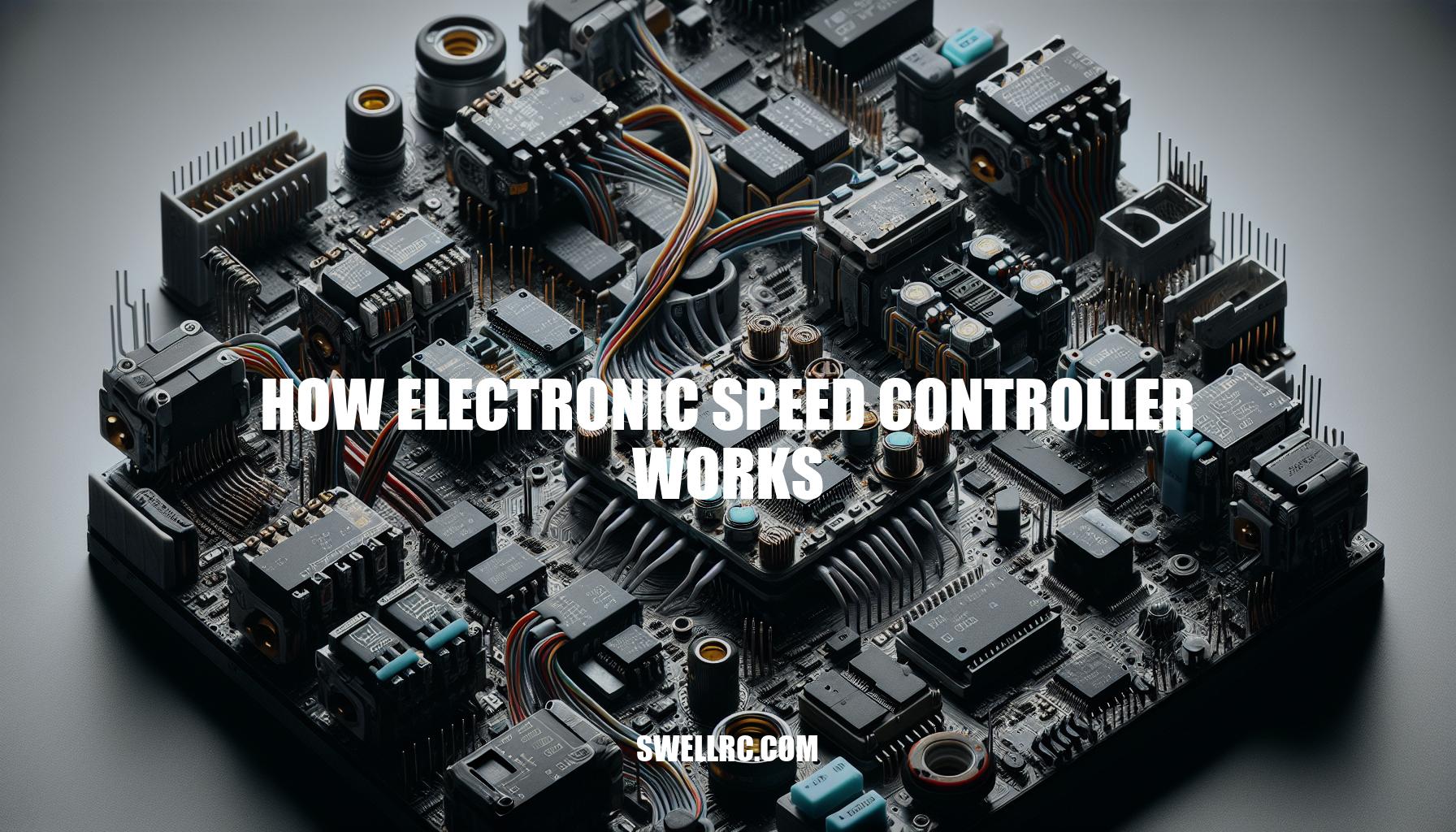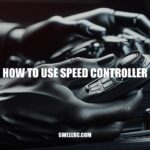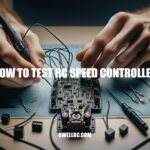Understanding How Electronic Speed Controllers Work
To understand the magic and science behind any remote-controlled gadget or electric vehicle, we first have to dive into one critical component–an Electronic Speed Controller, which we’ll fondly call ESC. Think of it as the conductor of an orchestra, synchronizing all the parts to bring harmony and stunning performance. Now, imagine the orchestra being your favorite drone or your electric car, and the ESC is the one waving the baton. That’s right! The ESC does that crucial job of regulating and controlling the speed of an electronic motor, ensuring your device performs just as you command. It might look like an ordinary piece of tech, but believe me, this little gizmo is the heart and brain of any electronic motion and power system. Pretty impressive, right? Let’s delve into what makes this genius tick!
Inside the ESC Brain: How It Controls Current Flow
Understanding the Heart of the Matter: How an Electronic Speed Controller Works. To truly grasp how an electronic speed controller (ESC) functions, imagine it as the brains of an operation, a central command station tirelessly working behind the scenes.
Fundamentally, an ESC comprises three significant elements. First up, we have the circuit that fashions the backbone of the entire system, actively controlling the current flow. Next, there’s the microcontroller. This mini maestro decodes the signals, akin to a secret service agent deciphering coded messages. Lastly, a switch operating network, often operating at a kilohertz frequency, serves as the executioner, adjusting power delivery based on the orders from the microcontroller.
Consider for example the popular E-Flite 30A Pro SB brushless ESC. This high-performing ESC operates at an impressive frequency of 8kHz, providing precise control over electric motors in a multitude of devices, from RC helicopters to drones. By decoding input signals and regulating power flow, it showcases just how an electronic speed controller works at an optimum level. So, you see, whether in your remote-controlled drones or the e-scooter you zip around town on, ESCs have you covered!
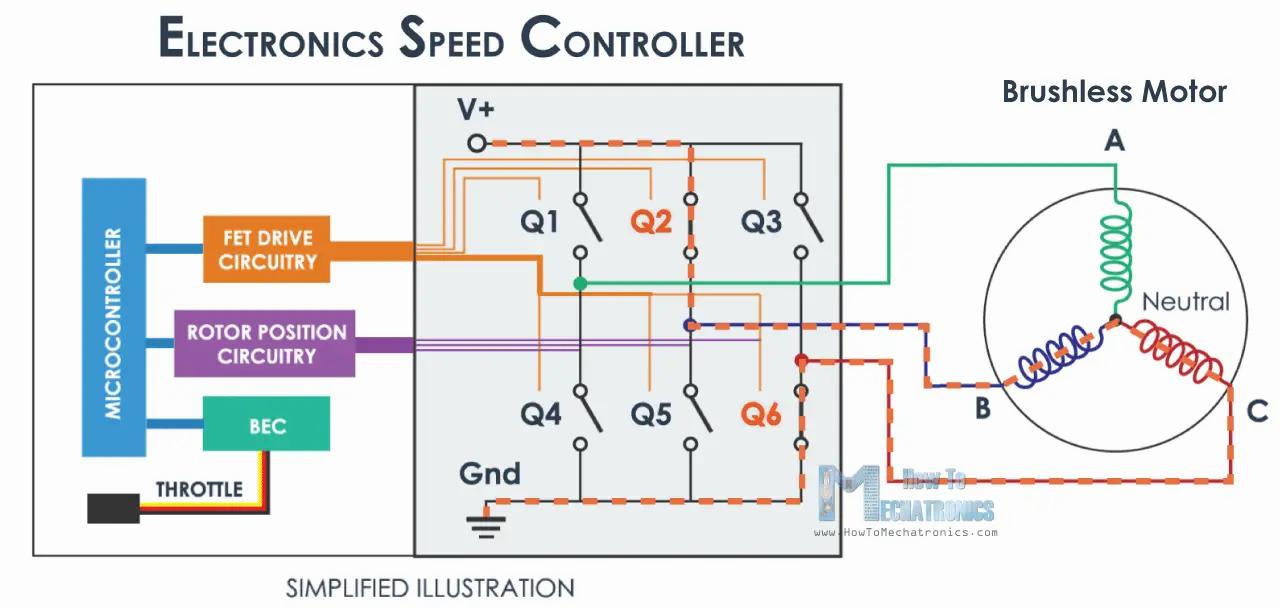
What is a microcontroller in an electronic speed controller (ESC)?
I’m glad you asked about the role of a microcontroller in an electronic speed controller (ESC). Picture it like this, just as a driver controls the acceleration and braking of a car, a microcontroller does the same for an ESC. What makes it even cooler? It has an essential role in communicating between the input device (typically a remote control) and the motor. It receives signals from the input device and translates them into adjustments in motor speed. Sounds simple, right? Thing is, microcontrollers are powerful little guys. They can process information at lightning speed, making your device respond almost instantly. So when you marvel at your drone or RC car reacting in a split second—you’ve got the microcontroller to thank for that. Talk about being the unsung hero of your toys! So yeah, that’s the gist of it. Microcontrollers in ESCs? Absolutely essential.
How ESCs Translate Electrical Signals into Smooth Movement
How electronic speed controller works might seem like rocket science, but it’s much simpler when broken down. At their core, ESCs are intuitive translators. These nifty devices converse with the motors they’re controlling using an intricate language spoken through currents and pulses. They receive instructions from a micro-controller, which runs the show from behind the scenes. The main lingo of this controller-to-ESC conversation is called “Pulse Width Modulation” (PWM). This dash-and-dot Morse Code of electronics allows the ESC to interpret varying lengths of high and low pulses as different speed commands. Now, if you’ve ever gotten into the nuts and bolts of building an RC drone or car, you’ve probably come across brand names like Lumenier. Their BLHeli_32 50A 4-in-1 ESC for example, a popular choice amongst drone hobbyists, employs a 32-bit microcontroller running at 72MHz to provide quick and precise PWM control. It’s always working, always adjusting, all to keep your device running smoothly and responsively. When you press the trigger to make your RC car speed up, it’s the unsung hero ESC that makes it all happen. Folks, this is no ordinary conversation – it’s a high-speed electrical ballet choreographed by the ESC. So the next time your drone takes a perfect turn in the air, appreciate the reliable, tireless ESC working its magic inside!

What is Pulse Width Modulation (PWM) in electronic speed controllers?
You know how a DJ modulates the pitch and intensity of music, to give you an unforgettable rhythmic experience? Well, Pulse Width Modulation (PWM) in electronic speed controllers functions similarly but in the world of electronics. It’s all about managing power supply to different electrical and electronic devices, making everything go smoother. The PWM basically acts like a gatekeeper, controlling the duration and timing of the energy that’s supplied. Picture it like a light dimmer switch, letting you control the intensity without turning it completely off or on. This guy can be crucial in many applications like driving motors or LEDs, maintaining just the right amount of power, not too much, not too less, ‘Goldilocks style’. Next time you’re on your drone, electric bike, or even a 3D printer device, remember it’s the PWM silently managing things at the back. So, let’s hear a round of applause for our unsung heroes, the electronic speed controllers. They are pretty cool…ain’t they?
The Future of ESCs: Brushless Technology
Now, let’s dig deeper into the world of ESCs and explore the two main types: Brushed and Brushless. The ‘Brushed’ variety is a model that has been with us for some time. Given their relatively simple construction and affordability, they have found application in a host of electronic devices. Yet, as technology and demands evolve, the ‘Brushed’ variety is increasingly perceived as less efficient and durable. Switching gears, we have what many consider the future of ESC design – the ‘Brushless’ category. When it comes to how electronic speed controller works, brushless motors are a game-changer. Yes, they demand a thicker wallet, but in return, they offer considerable robustness, longevity, and efficiency. It’s like a great investment that keeps giving back! Turnigy Plush-32 series, a popular choice among hobbyists and professionals alike, is an excellent example of a high-efficiency brushless ESC. These modern wizards are predominantly employed in RC drones and cars, where their superior performance truly shines. So, while you may initially wince at the price tag, chances are you’ll thank yourself later when you experience the sheer power and precision of brushless ESCs.
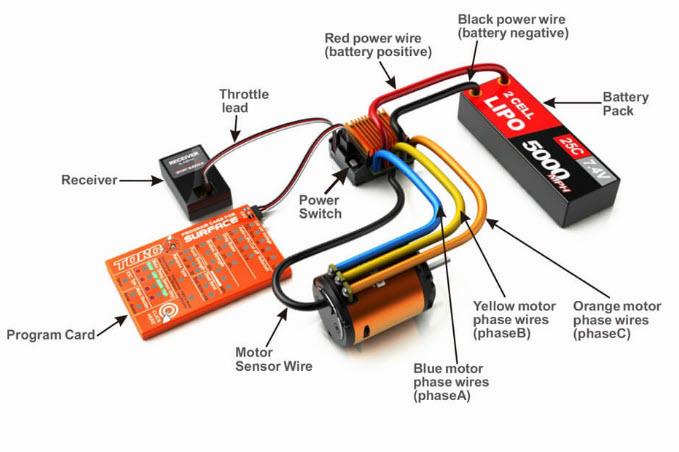
What is the difference between brushed and brushless electronic speed controllers?
In the exciting world of electronic speed controllers (ESCs), you’ve got two contenders – brushed and brushless. They’re both stars in their own right, but what’s the difference? Well, brushed ESCs are the old-timers, reliable, but maybe not the smoothest operators. They need mechanical brushes to keep the motor spinning, which can wear out over time and reduce performance.
On the other hand, brushless ESCs are the new kids on the block – sleek, efficient, and state-of-the-art technology kind of stuff. These guys use magnetic fields instead of brushes, which means less friction, more speed, and longer life. They’re a tad bit more expensive, but hey, quality doesn’t come cheap, right? Now, I can tell you’re a savvy individual and you want to get the most bang for your buck. So in your shoes, I’d lean towards brushless. More energy-efficient, more durable, less maintenance – that’s music to any hobbyist’s ears!
But let’s not forget that both are fit for purpose, and brushed ESCs, with their simplicity and cost-effectiveness, are still a good match for beginners or for applications that don’t demand top performance. So, don’t just throw them under the bus yet! Pick the one that suits your needs, budget, and experience. Happy tinkering, my friend!
Exploring ESCs and Electric Vehicles
The future of ESCs is nothing short of exciting. The global ESCs market is growing robustly, with a forecast by Research And Markets predicting a Compound Annual Growth Rate (CAGR) of 3.89% between 2021 and 2026. There’s more. The rise of clean energy automobiles is heralding a new era for ESCs. With major car manufacturers shifting gear towards electric vehicles, an enormous demand for electronic speed controllers, crucial to the function of these vehicles, will inevitably rise. Furthermore, as the popularity of brushless motors continues to surge (think RC drones or electric bikes), so will the need for brushless ESCs. Since they’re more efficient, durable, and quieter, they are perfect for devices requiring smoother and more precise control. Here’s an interesting fact: in RC applications, brushless systems, albeit more expensive, are replacing brushed systems due to their superior performance and longevity. So, if you’re wondering how electronic speed controller works or will work in the future, you can bet on witnessing a lot more of the brushless variety in a wide array of applications.
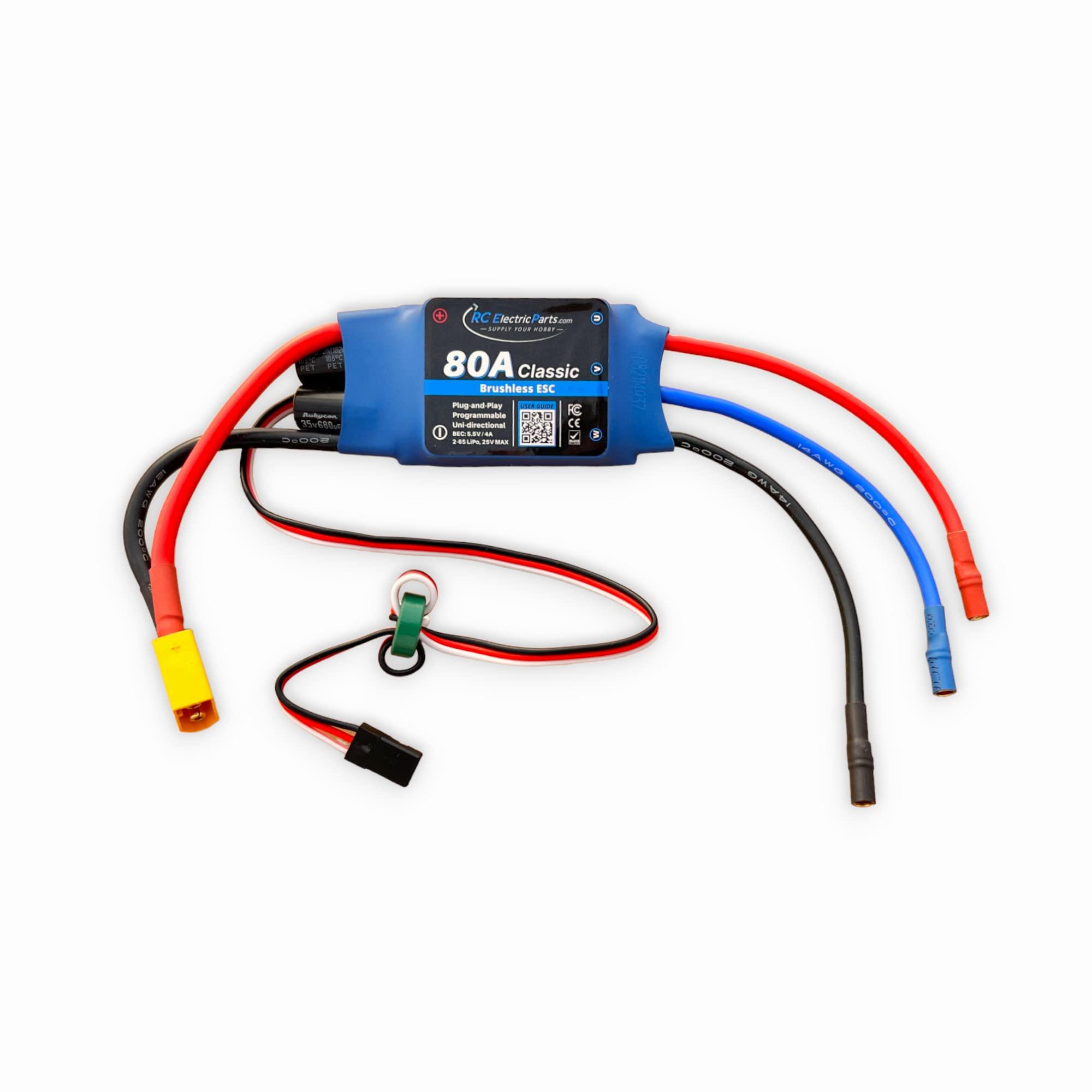
What is the difference between brushed and brushless ESCs and why are brushless ESCs becoming more popular in a variety of applications?
Right off the bat, let’s make something crystal clear: brushed and brushless ESCs (Electronic Speed Controllers) are not created equal, my friends. They’re similar in that they control the speed of your electric motor, but there’s a world of difference in how they get the job done.
Picture a brushed ESC as that reliable, old-school employee who’s been with the company since its inception. They always get the job done, but their methods rely on physical, touch-based systems to control motor speed, which, let’s face it, could be a tad less efficient. While there’s nothing wrong with tried and true methods, the wear and tear from constant physical contact can eventually lead to performance issues.
Now, imagine a brushless ESC as the new kid on the block. It’s got a lot of hype, and for good reasons. This tech-savvy newbie doesn’t need physical contact to control motor speed. A dream, right? They use magnetic fields to do the job, leading to less friction, which means less wear and tear, and ultimately, a much longer lifespan.
Another major tick on the list of why brushless ESCs are stealing the limelight is their power-efficiency game – it’s strong! They’re more energy efficient, and who doesn’t love an electricity bill that’s not through the roof?
Plus, it’s hard to ignore their stellar speed control precision. Brushless ESCs consistently deliver a smoother, more precise speed control, which is why they’re quickly becoming the darling of the drone world and any other application where motor speed accuracy is king.
So, while we all have a soft spot for the nostalgia of brushed ESCs, I think it’s safe to say that in the race of technology, brushed is truly becoming, well… old brush! The future seems all about the brushless. Superior longevity, efficiency, and precision – these guys are tough to beat, don’t you agree?
As we turn towards the cutting edge of ESC technology, the innovations are simply hard to ignore. Take the Castle Creations’ Phoenix Edge series, for instance. This ESC powerhouse has truly revolutionized how we perceive the potential of these tiny yet crucial devices. Beyond their basic yet crucial function of controlling motor speed, they now come with a built-in data logger. Now, isn’t that ingenious? This clever addition makes it possible for you to monitor and record system performance in real-time. It means you can tweak, adjust, and optimize every aspect of your RC vehicle or drone’s operation for those thrilling moments of absolute control and perfect maneuverability.
In wrapping up, there’s one thing that’s clear as day; while an ESC is a small component within electronic appliances, or “tiny conductors” if you will – it plays a monumental role in how electronic speed controller works. Whether it’s the drone flying high above us capturing breathtaking imagery, the electric car smoothly gliding down the highway, or even the humble RC car zipping around the kitchen floor, the ESC is steering the show. This powerful gadget ensures these devices operate seamlessly, efficiently, and safely, and the next time you see one of these devices in action, remember there’s this little orchestral maestro inside it, making it all happen.

